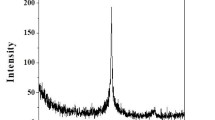Abstract
Stabilized iron-nanoparticles were used for the Cr(VI)-removal from acidic and neutral aqueous solutions (pH 1, 3, 5 and 7). The chromium interaction with the iron-nanoparticles was studied by a batch technique under different experimental conditions (e.g. pH, temperature, contact time, solid to liquid ratio) using 51Cr as radiotracer and gamma-ray spectroscopy. The results showed that the Cr-removal was fast and the interaction kinetics could be described by a pseudo-second order rate equation. The maximum Cr-removal was observed from solutions of initial pH 3. The sorption showed a positive temperature and solid to liquid ratio dependence. The experimental results were modeled using the Langmuir, Freundlich and Dubinin–Radushkevich isotherm equations and compared with literature data obtained using other sorbents. X-ray photoelectron spectroscopy (XPS) measurements were performed in order to obtain information about the mechanism of the Cr-removal by the iron-nanoparticles. It was demonstrated that the dominated process based on the Cr(VI) reduction followed by the simultaneous oxidation of iron.







Similar content being viewed by others
References
Lopez-Tellez G, Barrera CE, Balderas-Hernandez P, Roa-Morales G, Bilyeu B (2011) Chem Eng J 173:480–485
Kim Ki Do, Choi Dae Woo, Choa Yong-Ho, Kim Hee Taik (2008) J Mater Process Technol 202:569–575
Barnhart J (1997) Regul Toxicol Pharmacol 26(1):S3–S7
Chirwa EN, Wand Y (2000) Water Res 34:2376–2384
Richard FC, Bourg ACM (1991) Water Res 25(7):807–816
Davis A, Olsen RL (1995) Ground Water 33(5):759–768
Weng Chih-Huan, Lin Yao-Tung, Lin TY, Kao CM (2007) J Hazard Mater 149:292–302
Geng Bing, Jin Zhaohui, Li Tielong, Qi Xinhua (2009) Chemosphere 75:825–830
Foldesova M, Dillinger P, Lukac P (2000) J Radioanal Nucl Chem 245(2):435–439
Fendorf SE, Li G (1996) Environ Sci Technol 30:1614–1617
Guha S, Bhargava P (2005) Water Environ Res 77(4):411–416
Lee T, Lim H, Lee Y, Park JW (2003) Chemosphere 53:479–485
Hu CY, Lo SL, Liou YH, Hsu YW, Shih K, Lin CJ (2010) Water Res 44:3101–3108
Powell RM, Puls RW, Hightower ShK, Sabatini DA (1995) Environ Sci Technol 29:1913–1922
Cissoko Naman, Zhang Zhen, Zhang Jinghui, Xinhua Xu (2009) Process Saf Environ Prot 87:395–400
Wilkin RT, Su C, Ford RG, Paul CJ (2005) Environ Sci Technol 39(12):4599–4605
Wilkin RT, Puls RW, Sewell GW (2003) Ground Water 41(4):493–503
Uyuşur B, Ünlü K (2009) Environ Eng Sci 26(2):385–396
Rivero-Huguet M, Marshall WD (2009) J Hazard Mater 169:1081–1087
Xu Y, Zhao D (2007) Water Res 41:2101–2108
Wu Y, Zhang J, Tong Y, Xu X (2009) J Hazard Mater 172:1640–1645
Yuan Peng, Liu Dong, Fan Mingde, Yang Dan, Zhu Runliang, Ge Fei, Zhu JianXi, He Hongping (2010) J Hazard Mater 173:614–621
Fang Zhanqiang, Qui Xiuqi, Huang Ruixiong, Qiu Xinnhong, Li Mingyu (2011) Desalination 280:224–231
Shi T, Wang Z, Liu Y, Jia S, Changming D (2009) J Hazard Mater 161:900–906
Khezami L, Capart R (2005) J Hazard Mater B123:223–231
Anandkumar J, Mandal B (2011) J Hazard Mater 186:1088–1096
Nakano Y, Takeshita K, Tsutsumi T (2001) Water Res 35:496–500
Singh KK, Hasan SH, Talat M, Singh VK, Gangwar SK (2009) Chem Eng J 151:113–121
Baes CF, Mesmer RE (1986) The hydrolysis of cations. Krieger Publishing Company, Malabar 220
Ho YS, McKay G (1999) Process Biochem 34:451–465
Ho YS, Chiang CC, Hsu YC (2001) Sep Sci Technol 36(11):2473–2488
Ho YS, Ng JCY, McKay G (2001) Sep Sci Technol 36(2):241–261
Acknowledgments
The authors would like to thank the company NAΝOIRON s.r.o. for providing the iron-nanoparticles sorbent. M. Filippousi and G. Vourougis are also thankfully acknowledged for their help with the TEM examination.
Author information
Authors and Affiliations
Corresponding author
Rights and permissions
About this article
Cite this article
Bampaiti, A., Noli, F. & Misaelides, P. Investigation of the Cr(VI) removal from aqueous solutions by stabilized iron-nanoparticles using 51Cr-tracer. J Radioanal Nucl Chem 298, 909–914 (2013). https://doi.org/10.1007/s10967-013-2483-1
Received:
Published:
Issue Date:
DOI: https://doi.org/10.1007/s10967-013-2483-1




